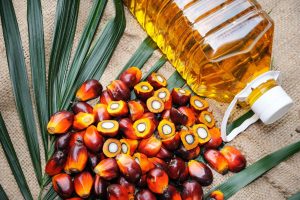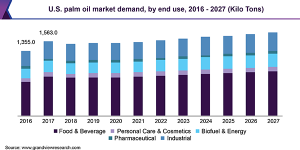Palm Oil an edible vegetable oil that comes from the fruit of oil palm trees, the scientific name is Elaeis guineensis. Two types of oil can be produced; crude palm oil comes from squeezing the fleshy fruit, and palm kernel oil which comes from crushing the kernel, or the stone in the middle of the fruit. Oil palm trees are native to Africa but were brought to South-East Asia just over 100 years ago as an ornamental tree crop. Now, Indonesia and Malaysia make up over 85% of global supply but there are 42 other countries that also produce palm oil.

Related Projects:- Edible Oils Projects
Preparation
Cleaned palm kernel is broken into smaller pieces with an impactor and then a roller mill. The kernel is then conditioned, flaked and sent to solvent extraction, or cooked and sent to full pressing.
Extraction
The solvent extraction process uses hexane or other solvents to wash the palm kernel oil from the prepared flakes. The design of the equipment varies so that Crown can optimize the amount of solvent and bed depth needed to efficiently wash the flakes, the contact time of the solvent and flakes, and the power and utilities needed to run the equipment. Palm kernel is processed with the Model III Extractor.
Desolventizing
Once the oil has been removed by the solvent, the solvent must be removed from both the flakes and the palm kernel oil. For the flakes, heat and steam are used to strip and recover the residual solvent. For the palm kernel oil, a distillation system is used to recover the solvent. The desolventized flakes are now a product and ready for sale as a good source of protein. The palm kernel can be further refined from a crude product to an edible product.
Related Books:- Oils And Fats
Oil Refining and Processing
Crude palm oil or palm kernel oil must be further processed to make an edible product. Edible palm oil is refined to improve the flavor, odor, color and stability using processes that degum, bleach, De acidify and deodorize the oil. These processes remove contaminants such as phosphatides, free fatty acids and pro-oxidants. Further processing of palm oil or palm kernel oil is sometimes desired and is achieved by modifying the oil to change its melting characteristics. Byproducts may be processed to create value-added products or reduce costs.
Biodiesel
Biodiesel is a renewable fuel derived from fats and oils. Although any source of fat can be used, palm oil plays a major part in this industry.
Oleo chemicals
There is a significant number of oleo chemicals made from the byproducts of palm oil and palm kernel oil. Whether it’s glycerin from a biodiesel plant or fatty acids from a fat hydrolysis plant, Crown offers many different processes to add value to these fat byproducts.
Related Projects:- Edible Oils, Non Edible Oils, Fats, Vegetable Fats and Oils
Market Overview of the Palm Oil Industry

The global palm oil market reached a production volume of more than 77 Million Tons in 2018, registering a CAGR of 6.8% during 2011-2018. The market volume is further projected to reach 107.6 Million Tons by 2024, expanding at a CAGR of 5.7% during 2019-2024. Originated from West-Africa, palm oil refers to an edible vegetable oil produced from the monocarp of the fruit of oil palm. It is the world's highest yielding oil crop, with an output 5-10 times greater per hectare than other leading vegetable oil crops. Due to its unique chemical composition, palm oil has longer shelf-life, low price and offers a numbers of nutritional benefits. It is cholesterol-free, easy to digest, and rich in carotenoids as well as Vitamin A. Thus, palm oil has the ability to enhance energy levels, prevent premature ageing, improve eye vision, boost immune system, and reduce the risk of cancer and heart diseases.
Related Videos:- Oils and Fats
Conclusion
“Palm Oil - Manufacturing Plant, Detailed Project Report, Profile, Business Plan, Industry Trends, Market Research, Survey, Manufacturing Process, Machinery, Raw Materials, Feasibility Study, Investment Opportunities, Cost And Revenue, Plant Economic “ Each detailed project reports cover all the aspects of business, from analyzing the market, confirming the availability of various necessities such as plant & machinery, raw materials to forecasting the financial requirements.
Noo_Art21
Tags:-
#DetailedProjectReport #businessconsultant #BusinessPlan
#feasibilityReport #NPCS #industrialproject #entrepreneurindia #startupbusiness #BusinessIdeas #StartupBusinessIdeas #BusinessOpportunity #PalmOil #PalmOilProduction #FoodIndustry #PalmOilBusinessPlan #PalmOilMarket #GlobalPalmOilMarke #PalmOilConsumption #PalmOilMarketProduction #PalmOilMarketImport #PalmOilMarketExport #VegetableOilIndustry #PalmOilProject #PalmOilBusiness